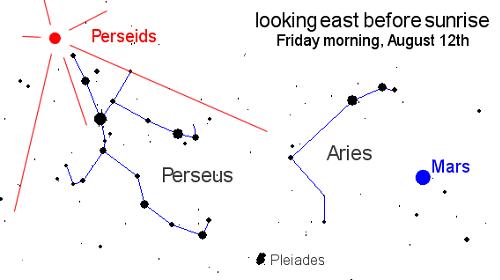Michal Levinstein

Direct link to this page: https://www.hayadan.org.il/persedis260705.html
The Israeli Astronomical Society also invites you to join a journey to the stars. The departure for the observatory is by organized transportation and the collection points are: the Observatory in Givatayim, Central Railway - Arlozorov parking lot, Tel Aviv, the Municipal Conservatory, Be'er Sheva.
Registration, costs and more details at this link
The Perseids arrive every year, starting at the end of July until August. Observers at the right time can see colorful fireballs, sudden eruptions and almost always - long hours of graceful streaks of meteors in the sky. Among the many nights of the meter there is the ideal night which this year comes out on 12/8/05.
The source of the meter is Comet Swift-Tuttle. Although it is not close to the Earth, its wide tail intersects the Earth's orbit. We surf through it every year in July-August. Tiny pieces of cometary ash hit our atmosphere at a speed of 132,000 meters/second. At such a speed - even a tiny amount of dust produces a colorful streak of light - a meteor - when it disintegrates upon entering the atmosphere. The meteor peak happens when the Earth is in the dusty part of the comet.
Meteors called Perseids fly out of the Perseus group, hence their name. The best time to watch is in the hours before sunrise - when Perseus is high in the sky - between 2 am and sunrise on 12/8. If you can move away from the volume lights - you can see hundreds of meteors. It's a good time to go outside!
The timing couldn't be more appropriate - the Perseids arrive on a hot summer night (this is a Northern Hemisphere meteor shower). Other familiar meteor targets (the Leonids arriving in November need a warm coat!).
And the bonus - Mars.
In the Aries group - right next to Perseus - Mars shines like a bright red sun. Just before sunrise look towards the east and you will see that it will be difficult to take your eyes off its spectacular sight. There is something magical about looking at it - maybe because of its reddish color, maybe because it doesn't sparkle like a real star - it is stable - you look at it and it looks back at you.
Earth and Mars converge for a close encounter on 30/10/05. See 12/8 as opening. Mars is already brighter than any other star in the sky. If you like August - wait for October.

And you'll like August - just imagine: it's 4 in the morning. the sky is dark A pleasant wind is blowing. Mars sends out reddish rays from the east, while meteors streak across the sky above.
For information on the NASA website
Astronomer
https://www.hayadan.org.il/BuildaGate4/general2/data_card.php?Cat=~~~223151532~~~56&SiteName=hayadan
